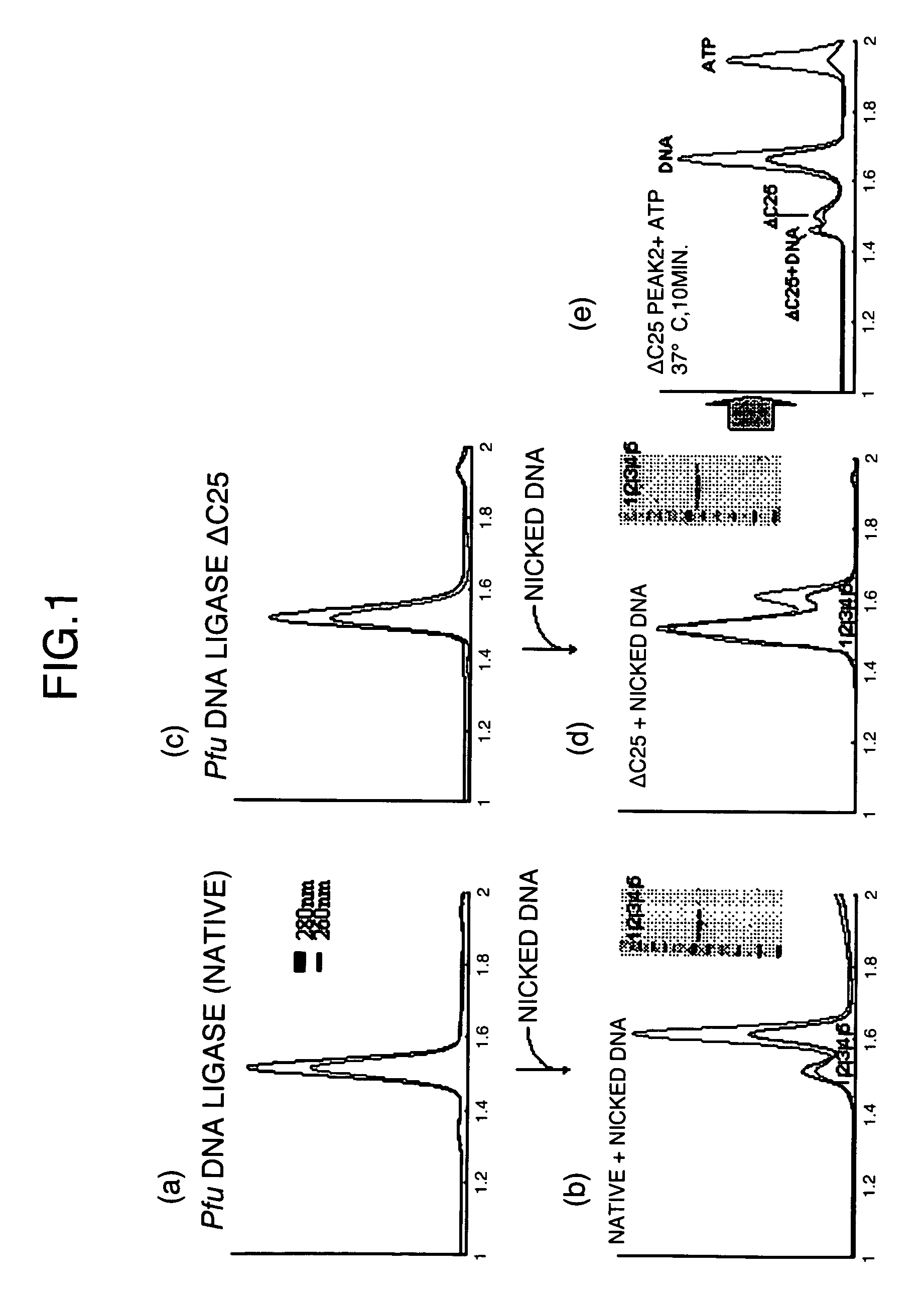DNA ligase mutants
a ligase and mutant technology, applied in the field of dna ligase mutants, can solve the problems of inability to adapt, poor thermostability of the ligase, and exceedingly low dna-binding ability of the thermostability of the dna ligase, and achieve rapid lcr, and excellent dna-binding ability and reactivity
- Summary
- Abstract
- Description
- Claims
- Application Information
AI Technical Summary
Benefits of technology
Problems solved by technology
Method used
Image
Examples
example 1
Preparation of C-Terminal Helix-Deleted DNA Ligase Mutant
(1) Preparation of P. furiosus Genomic DNA
[0025]P. furiosus DSM3638 was obtained from Deutsche Sammlung von Mikroorganismen und Zelkullturen GmbH and cultured according to the method described in the article (Nucleic Acids Research, Vol. 21, p. 259-265). Approximately 1.2 g of bacterial cells were obtained from 500 ml of the culture solution. These bacterial cells were suspended in 10 ml of Buffer L (10 mM Tris-HCl (pH 8.0), 1 mM EDTA, and 100 mM NaCl) and supplemented with 1 ml of 10% SDS. After stirring, the resulting mixture was supplemented with 50 ml of proteinase K (20 mg / ml) and left undisturbed at 55° C. for 60 minutes. Then, the reaction solution was successively subjected to phenol extraction, phenol / chloroform extraction, and chloroform extraction and then supplemented with ethanol to insolubilize DNA. The collected DNA was dissolved in 1 ml of TE solution (10 mM Tris-HCl (pH 8.0) and 1 mM EDTA) and reacted at 37° C...
example 2
DNA-Binding Ability of C-Terminal Helix-Deleted DNA Ligase Mutant
[0033]The interaction between the native ligase or the C-terminal helix-deleted mutant DNA ligase (ΔC25) obtained in Example 1 and 5′-phosphorylated nicked DNA was analyzed by gel-filtration chromatography to examine the substrate-biding ability of the DNA ligase mutant.
[0034]The 5′-phosphorylated single-stranded DNA was used to measure the binding ability between the DNA and the ligase. The DNA sequence was 5′P-TATAGCGAAGCTATATATAGCGAAGCTATA-3′ (SEQ ID NO: 17). The underlined parts are known to assume a stable hairpin structure (Nucleic Acids Research, Vol. 22, p. 2217-2221), and this single-stranded DNA was considered to serve as a stable nicked substrate. The DNA was dissolved in a buffer (10 mM Tris-HCl (pH 8.0) and 100 mM NaCl), then heated at 98° C. for 5 minutes with a thermal cycler, and gradually cooled to room temperature. This solution was applied to a gel-filtration column to separate a substrate of size co...
example 3
Thermostability of DNA Ligase Mutant of the Present Invention
[0037]Both the WT and mutant DNA ligases used in Example 2 were heat-treated at 85° C. for 20 minutes for the purpose of intentionally denaturing non-thermostable proteins at the initial stage of purification and simplifying subsequent purification procedures. In the heat treatment, the mutant exhibited thermostability comparable to that of the native.
[0038]According to the present invention, a DNA ligase mutant improved in binding ability and reactivity with DNA and further in thermostability is obtained. Therefore, the present invention is available in a biochemical research field, research reagent field, diagnostic reagent field, pharmaceutical field, and so on.
PUM
| Property | Measurement | Unit |
|---|---|---|
| pH | aaaaa | aaaaa |
| pH | aaaaa | aaaaa |
| flow rate | aaaaa | aaaaa |
Abstract
Description
Claims
Application Information
 Login to View More
Login to View More - R&D
- Intellectual Property
- Life Sciences
- Materials
- Tech Scout
- Unparalleled Data Quality
- Higher Quality Content
- 60% Fewer Hallucinations
Browse by: Latest US Patents, China's latest patents, Technical Efficacy Thesaurus, Application Domain, Technology Topic, Popular Technical Reports.
© 2025 PatSnap. All rights reserved.Legal|Privacy policy|Modern Slavery Act Transparency Statement|Sitemap|About US| Contact US: help@patsnap.com

